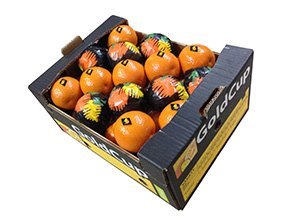Minneola
(Honeybell)
| Minneola | ||||||||
| Size | 1 | 2 | 3 | 3 | 4 | 5 | 5 | 6 |
| Diameter (mm) | 73-80 | 69-72 | 66-69 | 63-66 | 59-63 | 56-59 | 53-56 | 50-53 |
| Count 10 KG | 36 | 45 | 54 | 60 | 66 | 72 | 84 | 96 |
| Count 15 KG | 56 | 64 | 75 | 88 | 100 | 113 | 125 | 132 |
| Count 6 KG | 24 | 30 | 36 | 40 | 45 | 48 | 54 | 60 |

Originated in 1931 from a cross of Duncan grapefruit and Dancy tangerine, the Minneola has now found a niche in the variety composition of many of the world’s leading citrus-producing industries.
The trees are very vigorous and developed into large specimens which require sufficient room to develop fully. Large in size, the fruit has inherited some traits from both parents. The shape is round, with most fruits having a pronounced and distinctive neck which leads to its immediate recognition by consumers. The rind has not only exceptional color, being reddish-orange, but also has a particularly fine, smooth texture.
Mature Minneolas may feel slightly soft, giving the impression the fruit is puffy; this is often not the case. The peel is thin in relation to the fruit’s size, and is not difficult to remove since it is only moderately tightly adhering. However, care is needed during peeling to avoid puncturing the extremely delicate segment walls.
Minneolas have a unique, delicious and distinctive flavor, being rich, tart and aromatic. It has been shown to be very adaptable and excellent quality is achieved in widely different climatic zones such as the desert areas in California and Arizona, the Mediterranean climates in Cyprus, Israel and Cape Province, South Africa, as well as the semi-tropical summer rainfall areas of Argentina, Florida and Swaziland.